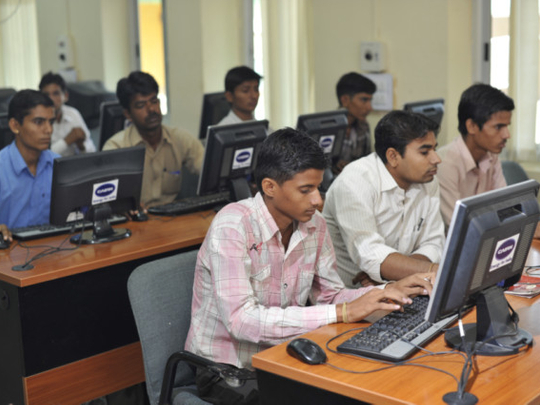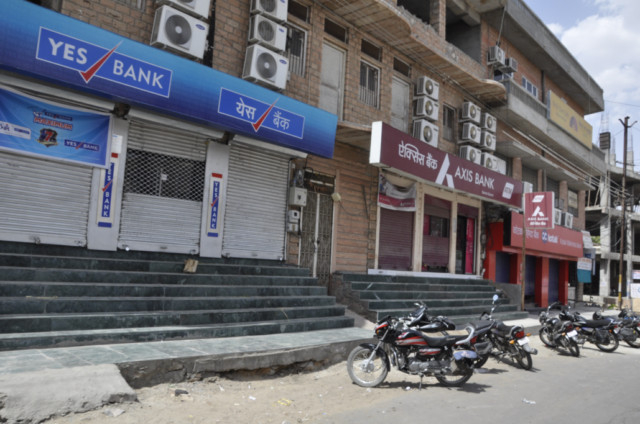
Rajasthan’s Barmer has recently registered a north Indian record sale of Mahindra vehicles. In past two years, Mahindra sold 4,300 sports utility vehicles (“Scorpio” and “Bolero”) in this border town and now, there is a waiting period of 150-200 days on these two SUVs. People in the country’s western outpost have also bought two Hummers, three Audis, and four Land Rovers and Mercedeses each, in this period.
Until some years ago, all that you saw on Barmer streets were camel carts, autorickshaws and two-wheelers, apart from some public transport buses.
Barmer’s was a dust bowl with temperatures rising to a baking 50C in summers. There was no water, no crop, no industry — forget restaurants, cafés or social life. People had land but it wasn’t worth much: it only produced bajra (pearl millet) once in four-five years when there was rain. Barmer was synonymous with stagnant backwardness. Government officials considered it a punishment if they were posted to Barmer.
Then, the British oil-exploration giant Cairn, in a joint venture with the Oil and Natural Gas Corporation (ONGC), discovered oil reserves in Mangala oilfield near Baytu, about 40 kilometres from the district headquarters, in January 2004. It was the largest onshore discovery in more than 20 years.
Cairn India went on to employ more than 10,000 people, mostly locals, between 2005 and 2009, the construction period.
In 2007, Raj WestPower Ltd (RWPL), a Sajjan Jindal company, began setting up a lignite power project in Barmer. State-owned Rajasthan State Mines and Minerals Limited (RSMML) entered into a joint venture with RWPL for lignite mining in Jalipa and Kapurdi reserves. This company, called the Barmer Lignite Mining Company Ltd, required land for mining. Farmers were offered unheard-of rates for their land.
Oil discovery and land acquisition changed Barmer’s destiny. The enterprising became multimillionaires by doing business with Cairn, and farmers who grazed cattle suddenly had so much money they didn’t know what to do with it, after their land was acquired for power plants and lignite mining.
Barmer became a bustling town. Land rates skyrocketed, and people bought luxury sedans and expensive SUVs to flaunt their millions. Success stories spawned by oil and lignite could be heard all over the dusty, sleepy town.
Fifty-year-old Tan Singh started off as a road-roller driver and graduated to government contracts. In 1999, his annual turnover was Rs20 million (Dh1.4 million). Today, he owns a C-class Mercedes, an Audi Q7 and two Toyota Fortuners. A palatial bungalow in the centre of the city is under construction. He also owns five hotels, and showrooms and complexes in various cities.
“I owe my success to oil and lignite,” he says. “I got a contract from Cairn in 2002 and then never looked back. Today my annual turnover is Rs1 billion.” Last year, he paid Rs40 million as income tax and Rs80 million as sales tax.
Thirty-year-old Azad Singh Rathore plunged into the family business of medical shops in Barmer after a diploma in pathology in 2002. “There were limited business opportunities in this sleepy town and people had limited sources of income, but oil discovery changed that,” he says, as he marvels at his latest acquisition, a Mercedes-AMG. Only last year, he bought his dream bike, a Harley Davidson, for Rs900,000.
Rathore’s Hitkari and Swaraj Enterprises provides services and facilities to oilfield companies, which include accommodation and warehouse, bunk and container, catering and travel arrangements, and supply of safety equipment.
Kishan Lal Punia, 45, doesn’t like to drape a dhoti around his waist now. He changed to shirt and trousers the day his barren 32 hectares of land got him Rs60 million. This land produced Rs60,000 worth of pearl millet a year. Punia bought 43 hectares of irrigated land for Rs16 million, and deposited Rs20 million in bank. He owns one 18-wheel and two 12-wheel trucks, one dumper, one Bolero and one Scorpio. He makes Rs100,000 a month from renting out the vehicles. These days he is busy overseeing the construction of his 0.8-hectare multistoried farmhouse in the city.
Barmer has undergone a sea change after the discovery of oil. In 2003, there were just two hotels in the city with only one air-conditioned room. Today, there are 18 hotels with 177 air-conditioned rooms. The city also has a hotel suite that costs Rs9,000 a night.
When work peaked at Mangala oilfield, house rents went up. A four-bedroom house in posh Mahavir Nagar, which would otherwise fetch Rs15,000 as rent, became worth Rs100,000 a month. “The funny thing was a lot of house owners in that locality rented their houses and moved into cubbyholes in other areas. Renting your house became a big source of income,” says Vikram Singh Rathore, project officer with Legal Mitra Foundation, an NGO.
RWPL offered Rs58,000 an acre (Rs143,320 a hectare) for land in 2007. In September 2009, when acquisition began for lignite mining, farmers agitated and forced the company to hike the compensation to Rs371,000 an acre. On a day in September that year, 272 people made Rs2.67 billion.
Poor farmers became millionaires. They moved into the city to fulfil their dream of having a house there. Those who walked or pedalled bicycles got into SUVs. Mahindra launched a scheme of giving one tractor free on sale of 20. For the first time, there was a waiting period for Boleros.
OS Motors, which sold 200 Boleros a year until some years ago, has sold 2,000 units in the past three years. The company says it sold 150 tractors in 2006; today they are selling 800 a year.
In 2006, when Barmer experienced floods and journalists descended in hordes to report a strange phenomenon — there were no private banks in the city. But, after the latest land acquisition drive in January 2011, people decided to invest the compensation in fixed deposits. They got more money since the rate of land had doubled to Rs 740,000 an acre. This led to a bank street, where one private bank after another opened its branch.
The local economy is humming. Dozens of companies have set up shop here, all offering the allied services that any oil industry needs. You don’t need to go to Jodhpur or Ahmedabad for medical treatment. Hundreds of nursing homes have come up in Barmer. Leading clothes brands have opened stores here.
Even detractors, such as the farmers who led the protest against land acquisitions, decided to flow with the growth tide. Ram Singh Bothiya, who spearheaded agitation against the acquisition in Kapurdi, 25 kilometres from Barmer, rode a motorcycle and earned Rs10,000-15,000 a month from a tent house before he turned into a contractor for Cairn and RWPL. Bothiya now makes about Rs1.5 million a month. He drives an Mahindra XUV500, and owns four Boleros, besides a few JCB machines and cranes.
After a degree in pharmacy, Lalit Kiri, 33, went to Muscat for work but he realised the degree had no value in the Gulf country, so he got into the furniture business. Kiri returned to India in 2002 when he fell ill, and what a blessing in disguise it turned out to be. Cairn had just arrived in Barmer. Kiri set up Kiri and Company Logistics Private Limited to supply products and services associated with the oilfields.
In 2004, when Precision Drilling, the Canadian company, came to Mangala oilfield, they needed portable bunkhouses — plush five-star facility accommodation — on hire. Kiri had them made for Rs500,000 to Rs 2 million, and rented them out to earn in the range of Rs 15,000 to Rs 100,000. Today, he has rented out about 200 bunkhouses to different companies. He also does catering and supply of construction equipment.
Now, Kiri is diversifying into offshore oil and gas exploration, which, he says, is more dynamic, more technical and less competitive. Six months ago, he acquired a Mumbai-based company, which specialises in this area.
Kiri’s turnover last year, when he acquired a vessel, was Rs200 million. His target for next year is Rs1 billion.
Besides these big businessmen, who owe their millions to oil, Cairn has trained more than 900 young men and women from nearby villages in carpentry, welding, computer skills and repair of mobile and electronic appliances at its enterprise centre.
Before the oil discovery, Raviban Bhatti, 30, earned a few thousand rupees a month and could barely support his family of two daughters. After undergoing training at Cairn, he now runs two mobile-phone repair shops and has become a trainer at the enterprise centre. He earns Rs45,000 a month and is building a house for his family.
“We could either raise cattle, mainly goats, or make handicrafts. We used to go to neighbouring Gujarat for work but now I have disposable income,” says Bhatti, who now plans to send both his daughters to school.
Bhanwar Lal Huda, 28, made ends meet by painting signposts. When Cairn arrived, it needed hundreds of signposts, and he found himself in demand. Huda now employs 22 people and makes composite aluminium signposts for Cairn and other companies.
Barmer is set for more growth. The Rajasthan government recently signed an agreement with the Hindustan Petroleum Corporation Ltd (HPCL) to set up a 9 million-tonnes-per-annum refinery and petrochemical complex in Lilala, in Baytu tehsil. The project, which will bring employment to about 100,000 people directly or indirectly, will acquire 1562 hectares of land to process crude produced by the Mangala, Bhagyam, Aishwariya, Raageshwari and Saraswati oilfields. Farmers have now become more ambitious. They are demanding compensation at the rate of Rs25 million per acre for their land.
The Barmer district administration has also begun the process of acquisition of around 800 acres of land for Shivkar Lignite Mining and Barmer Lift Project.
Every day, Cairn India pours an extraordinary Rs150 million in royalties into the Rajasthan government’s coffers. For Kiri, with the right share of royalties, there should be no stopping Barmer. “I think Barmer can become another Dubai very soon,” he says.
Rakesh Kumar is a writer based in Jaipur, India.




